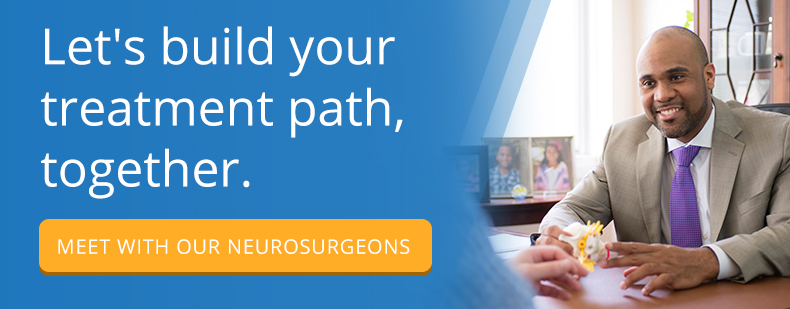Chiari malformation is a rare condition that can cause pressure on the brainstem and spinal cord. If you have been diagnosed with this condition and are experiencing symptoms, you should learn more about your treatment options so you can choose one that matches your expectations.
Why You May Need Chiari Malformation Surgery
You may need to undergo Chiari malformation surgery because of a congenital condition that causes your brain to grow downward through your skull’s foramen magnum, the hole where your spinal cord connects to the brain. When your skull’s shape forces your brain to grow in this way, you can experience a range of symptoms, including:
- Headaches
- Neck pain
- Difficulty swallowing
- Muscle weakness and numbness
- Balance issues
- Difficulty performing tasks that require fine motor skills, such as writing
- Vertigo
- Insomnia
- Blurred or double vision
- Sleep apnea
Most people with Chiari malformations experience little or no symptoms. Those with mild symptoms can typically be managed without surgical intervention. However, if your symptoms are severe, you may need surgery to avoid progressive, potentially irreversible problems.
Surgical Treatment Options for Chiari Malformations
Chiari malformation surgery can be categorized into both traditional and minimally invasive categories. Talk to your surgeon to determine which type of surgery is best for you.
Traditional Chiari Treatments
Traditional surgical treatments for Chiari malformation include:
- Dural opening Chiari decompression
- Cervical laminectomy
- Spinal Fusion
- Cerebrospinal fluid (CSF) diversion
Dural opening Chiari decompression surgery involves removing pieces of the skull and expanding the membranous covering of the brain to create extra room for the spinal cord and brainstem. During dural opening Chiari decompression surgery, your surgeon will remove a small piece of bone from the back of your head.
Cervical laminectomy involves removing part of the upper vertebrae. This is typically performed as a component of the decompression surgeries, this also creates more space and reduces the amount of pressure that the brain puts on the spinal cord.
Spinal fusion is used in conjunction with decompression surgery when patients have coexisting conditions such as Ehlers-Danlos syndrome, which affect the body’s connective tissues. Fusing sections of the spine gives your head and neck greater stability.
Chiari malformations can cause an unusual amount of cerebrospinal fluid to accumulate in the central nervous system. As the amount of fluid increases, it puts pressure on the brain and spinal cord. With CSF diversion, your Chiari malformation surgeon will insert a tube that redirects cerebrospinal fluids to other parts of the body, where it can be reabsorbed. People with congenital Chiari malformations rarely need this treatment. The procedure is more common in patients with secondary malformations caused by lesions that increase the brain’s size.
Minimally Invasive Treatments for Chiari Malformations
Minimally invasive treatments for Chiari malformations use smaller incisions to achieve the same goals as traditional surgeries. Not all surgeons are trained to perform minimally invasive Chiari malformation surgery, so you should look for a New Jersey Chiari doctor who has experience in this area.
Minimally invasive Chiari decompression is an excellent treatment option for many severely symptomatic patients who require surgery.
Minimally invasive Chiari decompression surgery, pioneered by our team here at Neurosurgeons of New Jersey, achieves the same result as traditional decompression treatments for Chiari malfunctions. Because of its minimally invasive approach, however, there are added benefits, such as:
- Smaller incision
- Reduced blood loss
- No need for grafting (avoiding need for separate donor site or implantation of foreign material/tissue of animal origin)
- Watertight closure
- Shorter surgical time
- Reduced risk of postoperative complications (cerebrospinal fluid leak, pseudomeningocele, meningitis, brainstem sag)
- Less postoperative scar formation (which may reduce chance of symptom recurrence)
- Less pain medication use post-op
- Quicker post surgical recovery
Choosing a New Jersey Chiari doctor trained in minimally invasive techniques can shorten the amount of time you spend in surgery, causes less pain and reduces the risk of postoperative complications like meningitis and fluid leaks. Since minimally invasive procedures use smaller incisions, you can expect to recover faster than patients who undergo traditional surgeries for Chiari malformations.
What to Expect During Your Recovery
Your experience during recovery depends on the type of Chiari malformation surgery you undergo. Generally, you can expect to stay in the hospital for one to three days. During this time, the hospital staff will monitor your vital signs and keep you comfortable. After a few days, your doctor will discharge you into the care of someone you trust.
Luckily, you get to spend most of your recovery time at home. Depending on several factors, your recovery could take anywhere from four to twelve weeks. Patients who choose minimally invasive surgeries usually recover sooner than those who undergo traditional procedures.
You may experience some discomfort while you recover at home, and your doctor will likely prescribe pain medication and muscle relaxants to control it. Ice packs can also curb muscle spasms.
You will have several post-operative restrictions while you recover from Chiari malformation surgery. It’s important that you avoid any activity that increases intracranial pressure. These activities include bending over, prolonged coughing, sports and any other strenuous motions. Avoid housework until your doctor checks your progress and says that it is safe for you to be more active.
Fatigue is common during the recovery process. As you recover, you can gradually return to your normal activities. Follow your doctor’s instructions, so you can regain lost strength and flexibility at a healthy rate.
A significant percentage of patients who undergo Chiari malformation surgeries experience symptom improvement. It is possible, though, that you’ll need continued medical treatment to keep symptoms at bay. You should maintain contact with your doctor, so you can continue to make educated decisions about any continued treatments you might need.


